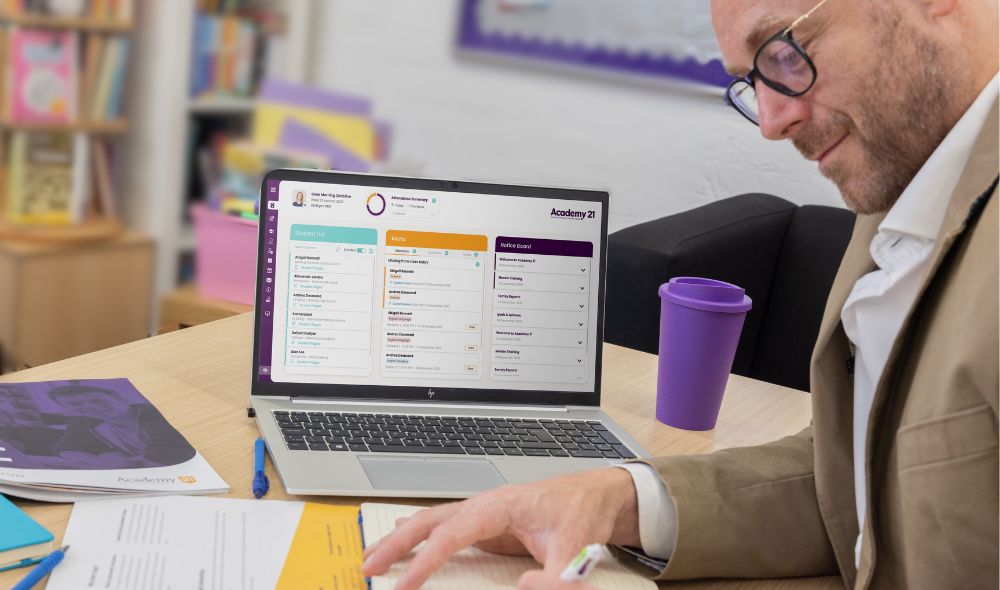What does an alternative provision curriculum look like?

Alongside the environment and support offered in alternative education settings, alternative provision (AP) curriculums play a vital role in supporting students who aren’t currently able to access mainstream education.
These specialised programmes offer a lifeline to young people who may be facing significant or complex challenges, from social and emotional needs to EBSA (emotionally based school avoidance) to illness. Of course, since these needs often require a diverse range of solutions, the vast landscape of alternative provision can leave many uncertain about what an effective alternative provision curriculum looks like.
How does it differ from or connect to mainstream education? What standards must AP curriculums adhere to? What are the different elements that contribute to the curriculum’s aims and successes?
From national curriculum requirements to attributes like innovation and flexibility, let’s take a look at the factors that make up a balanced, supportive, and high-quality AP curriculum.
The foundations of an alternative provision curriculum
There is no one-size-fits-all approach to education, which is part of the reason why alternative provision is so important to begin with. This also means that even within the AP sphere, curriculums can vary.
What are the curriculum requirements?
While mainstream schools typically follow the national curriculum closely, there is no legal requirement for alternative provision to do the same . Instead, regulations mandate that AP settings must provide a broad and balanced curriculum that meets students’ needs. In most cases, this includes:
- Ensuring the curriculum meets all needs: academic, personal, and social
- Implementing teaching that boosts attendance and engagement, boosting motivation and confidence in the classroom
- Enabling students to take appropriate qualifications and achieve good outcomes
- Providing teaching in important core subjects such as English, maths, science, and ICT
- Working to clear objectives and laying out students’ next steps after their AP placement
Why follow the national curriculum?
That being said, many alternative provision settings find that mirroring the national curriculum can be highly beneficial. At Academy21, we’ve found that using the national curriculum as the foundation of our teaching helps students get back on track for key educational standards, supports a smoother transition back into mainstream school, where possible, and ensures students achieve recognised outcomes.
This mirroring doesn’t necessarily mean creating a 1:1 replica of the typical classroom curriculum. For example, AP settings may also offer alternative courses that prepare students for further education or other future pathways. Certified functional skills courses, for example, can provide valuable foundations in literacy and numeracy.
Similarly, AP providers may also adapt mainstream subjects to better suit their environment and their students’ needs (for example, implementing different teaching methods or adjusted timelines), whilst maintaining high standards and research informed practice.
Whatever the finer points of the curriculum, what’s key for alternative provision is that providers maintain a commitment to rigorous standards, a high level of progress, and accreditations, just as mainstream schools would be expected to. For most AP academies and PRUs, this is typically measured through Ofsted inspections — including the new OEAS (Online Education Accreditation Scheme) for online providers.
With the foundations in place, alternative provision settings are then equipped to tailor their curriculums to student needs in a range of different ways.

What sets alternative provision curriculums apart?
While many alternative provision settings build on mainstream foundations, you’ll often find many unique attributes that set strong AP curriculums apart.
These factors are typically shaped and guided by the specific objectives of the AP setting in question. At Academy21, for example, we work to bring every child a high-quality education with DfE-accredited provision, leveraging our online environment to build confidence and help students achieve the best outcomes.
In our case, and in the case of many other high-quality AP settings, the following features are some of the most key.
Tailored, flexible learning
One of the hallmarks of a great AP curriculum is its ability to meet the needs of the individual pupil in a way that mainstream school hasn’t been able to up to that point. Typically, this means the curriculum needs to be flexible and adaptable, so that learning can be tailored to each young person more easily, fitting around other commitments, needs and interventions designed to work together to help a child succeed
In some alternative provision settings, this may come in the form of forgoing large parts of the national curriculum altogether in favour of a specifically designed programme. With AP that teaches the national curriculum, however, flexibility may mean taking adaptive approaches that accommodate different learning needs.
Ultimately, they key lies in striking the right balance between structure and personalisation. Pupils need organisation, but that structure should be built to allow for individual adjustments or to meet a diverse range of needs from the outset. For example, an AP academy may create adapted materials for students with special educational needs, take a quality-first approach where materials are broadly accessible to all students, or a combination of both. This ensures that students receive a consistent, high-quality education while also benefitting from personalised support.
Often, AP curriculums are also flexible in their timelines. For example, here at Academy21, we offer several 1-year GCSE programmes and rescue courses designed for our pupils who may have faced learning gaps but are still aiming to get back on track in Year 11. In other cases, course may be offered over a longer period than usual for young people who need more time to work at their own pace.

Well-rounded development
Just like in any great education environment, a strong alternative provision curriculum goes beyond the core academic subjects to address pupils’ needs holistically across the board. Given the diverse range of reasons why children may require alternative provision, it’s particularly crucial that AP curriculums focus on social, emotional, and mental health (SEMH).
Again, how an AP setting chooses to incorporate well-roundedness will vary widely. The inclusion of PSHE (Personal, Social, Health and Economic) in the curriculum is a popular strategy. Also delivered in mainstream schools, PSHE is designed to equip students with the important skills and understanding they need to live happier, safer, and more balanced lives. PSHE is part of our curriculum at Academy21 too, giving Key Stage 4 pupils the opportunity to cover a wide range of topics (from mental and physical wellbeing to cyber safety to personal finance) on a weekly basis.
A focus on outcomes
In a large part, alternative provision is about the journey: getting students from a state of disengagement or from prolonged periods without education into a position of confidence and achievement. Of course, that doesn’t mean that outcomes should be completely disregarded — far from it, in fact.
As AP providers, we constantly ask ourselves: where do we want to see students after they leave our provision? For many, the aim is a return to mainstream school. In these cases, the curriculum must facilitate a seamless transition, ensuring that students are academically and emotionally prepared to reintegrate into a physical classroom.
For those who cannot return to mainstream school (perhaps, for example, due to long-term health complications), the focus turns to outcomes that set pupils up for life beyond the school years. In this case, the AP setting’s curriculum must equip students with the tools and know-how to succeed in adult life, whether that’s achieving strong GCSE and A Level grades or developing crucial life skills such as organisation, time management, and resilience.
Innovation for engagement
While alternative provision doesn’t have to be groundbreaking by nature, we’ve found that innovating the learning experience for vulnerable students can have truly unmatched benefits. As such, you’ll often find that many AP curriculums do things a little bit differently, even when they are teaching the national curriculum.
Often, innovation stems from a need to boost engagement: one of the key challenges faced in many AP settings. Many pupils are referred to alternative provision specifically due to disengagement in the classroom, stemming from difficulties such as behavioural challenges. Other students in need of AP may have generally enjoyed school, but now find themselves demotivated due to extended time away from the classroom.
Working to create a more engaging way of learning within the curriculum can be incredibly beneficial in getting these young people back on track and reigniting their enthusiasm for education.
As an online AP provider, for example, Academy21 carefully and thoughtfully uses modern online education pedagogy and a range of proven yet cutting-edge technologies that help keep students focused in class, dedicated to their progress, and interested in learning. Our state-of-the-art digital classrooms, for example, give teachers powerful tools to manage behaviour effectively. The ability for discreet, individual interventions ensures students who need help staying focused can get the attention they need without disrupting the lesson pace for the rest of the class.
Another example is our artificial intelligence-powered personalised learning system, which gives each student their own pathway and activities to solidify their learning after class in core subjects — all based on their unique pace, strengths, and areas for improvement. Not only has this improved student progress, it has also boosted confidence and enthusiasm as students see tangible developments in their learning.
That being said, innovation in AP curriculums isn’t just about initiatives like using the latest technology. It’s about finding new ways to connect with students and provide the value they need to thrive (whether that’s through tech, teaching methods, or approaches to curriculum delivery).
Tracking and involvement
Last, but certainly not least, one of the biggest key attributes that often sets alternative provision curriculums apart is the level of tracking, monitoring, and close involvement built in. To be effective, AP often needs a more holistic approach to tracking than mainstream schools to ensure that every pupil is making progress and staying on the right path.
You’ll often find this woven into all aspects of an alternative provision setting’s delivery, including in the structure of the curriculum itself. Rather than broad, sweeping units of study, the curriculum may be broken down and delivered in smaller, more measurable chunks that shift between topics more regularly. In turn, this granular approach to progress allows for more frequent monitoring and assessment points, enabling AP educators to pinpoint exactly where a student may be struggling. When teachers have a cleared picture of where each young person is in their learning, they’re able to take a more responsive approach to bridging learning gaps by revisiting topics, providing extra resources, or recommended one-on-one support.
Likewise, alongside tracking students from a top-down level, great AP is set apart in how it keeps all key stakeholders involved in the journey — including parents and students. For instance, the curriculum may include regular self-assessment opportunities for students to reflect on their own progress, goal-setting activities integrated into the learning process, or modules broken down to ensure that knowledge is built topic-by-topic. You’ll often see a level of involvement that keeps students more engaged and motivated in their own schooling experience and ensures parents and caregivers can keep up the momentum and support at home too.

The power of a great AP curriculum
As is clear, the landscape of alternative provision is often as diverse as the students it serves. From curriculums that mirror mainstream schools to programmes designed around specific needs, each AP setting differs from the next. What unites them, however, is a commitment to re-engaging students and paving the way for them to flourish.
In our experience at Academy21, when attributes like quality, flexibility, outcomes, and innovation come together, the potential for transformation is remarkable. Our young people who once felt detached from their education are able to gradually make their way back to enjoying school and progressing in the classroom, and successes that may have been thought impossible are brought to life.
Get started with Academy21
At Academy21, we offer DfE-accredited online alternative provision that combines the rigor of national standards with the right environment, personalisation, and support for the pupils we work with.
Contact us today to learn more about our variety of short and long-term solutions for young people with a range of complex needs.
Written by
Academy21
Posted on
26/07/2024
Updated on
26/09/2024
Topic
Student successPost type
Blog


